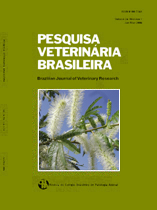 |
|
|
|
Year 2010 - Volume 30, Number 10
|

|
Congenital malformations in ruminants in the semiarid of the Brazilian Northeast, 30(10):807-815
|
ABSTRACT.- Dantas A.F.M., Riet-Correa F., Medeiros R.M.T., Galiza G.J.N., Pimentel L.A., Anjos B.L. & Mota R.A. 2010. [Congenital malformations in ruminants in the semiarid of the Brazilian Northeast.] Malformações congênitas em ruminantes no semiárido do Nordeste Brasileiro. Pesquisa Veterinária Brasileira 30(10):807-815. Hospital Veterinário, Laboratório de Patologia Animal, Centro de Saúde e Tecnologia Rural, Universidade Federal de Campina Grande, Campus de Patos, Avenida Universitária s/n, Bairro Santa Cecília, Patos, PB 58708-110, Brazil. E-mail: dantas.af@uol.com.br
Congenital malformations caused by the ingestion of Mimosa tenuiflora have been reported in ruminants in the semiarid of the Brazilian Northeast. This paper reports malformations diagnosed in ruminants, from 2000 to 2008, by the Veterinary Pathology Laboratory of the Federal University of Campina Grande, Patos, PB, in municipalities of the states of Paraíba, Pernambuco and Rio Grande do Norte. During the period, 47 (3.48%) out of 1.347 ascensions were reported as malformations. Based in the type of malformation and in the origin of the animals, malformations were divided in: 1) caused by the ingestion of M. tenuiflora, and 2) sporadic malformations of unknown causes. In sheep, 21 out of 418 ascensions were malformations, being 18 (4.3%) of malformations caused by M. tenuiflora and 3 (0.71%) of sporadic malformations. In cattle, 14 out of 434 ascensions were malformations, from these 8 (1.84%) were caused by M. tenuiflora and 6 (1.38%) were sporadic malformations. In goats, 12 out of 495 ascensions were malformations, being 9 (1.81%) malformations related with the ingestion of M. tenuiflora and 3 (0.6%) sporadic malformations. More frequent malformations caused by M. tenuiflora were arthrogryposis, micrognatia, palatoschisis, microphtalmia and unilateral or bilateral hypoplasia or aplasia of the incisive bones. Sporadic malformations were acephaly and hermaphrodite, dicephaly and malformations of mesenteric vessel in sheep; atresia ani in three goats; and hydranencephaly, atresia ani, ribs malformation with eventracion, cerebellar hypoplasia with hydrocephalus, pulmonary choristoma and meningocele, and siamese twins in cattle. A case of cerebellar hypoplasia with hydrocephalus was negative on immunohistochemistry to bovine viral diarrhea virus. Malformations caused by M. tenuiflora occurred during the whole year. The highest frequency in sheep seems to be associated with the consumption of the plant by ewes after first rains, in the first two months of gestation, when they are supplemented with concentrates, and M. tenuiflora is the main green forage available. Malformations occur mainly in degraded areas of native forest (caatinga) invaded by M. tenuiflora, with lesser variety of other species. |
| |
|
|
| |
|
 |